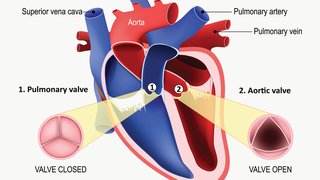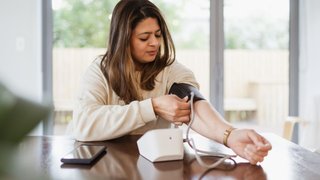
Think about the last time you went to the doctor. Did your physician look like me? Most likely not.
With dedication, persistence, and a solid support system, I’ve earned a position as a cardiology fellow, helping patients from all walks of life get the care they need. I’m doing what I love every day, and it all began with a childhood friendship and one moving book.
Data from the American Medical Association show that in 2011 only 2.5 percent of all medical school applicants were African-American men. There are many reasons for this, namely disparities in health care and fewer educational opportunities in inner cities. But it is possible – and necessary – for young people like me to become doctors.
Big differences in inner city health care
I was born in the small town of Kokomo, Indiana. When I was 7, my parents moved to Indianapolis so my dad could pastor a church that happened to be in the inner city. As a result, I spent a lot of time in those neighborhoods as a kid. From an early age, I could appreciate a stark contrast in the health care that my friends from church received compared with the care my parents were able to afford.
I have asthma, and I would see a pulmonologist every six months or so to make sure I was taking the right medication and that my condition was under control. A good friend of mine from church also had asthma, but he wasn’t able to see a doctor for preventive care. I remember he would often miss activities at church and school because of complications with his asthma – the same condition that I was able to manage with preventive care. That disparity has always stuck with me.
Then, in fourth grade, I wrote a book report about Gifted Hands by Dr. Benjamin Carson. The book chronicled his life growing up in inner city Detroit and overcoming obstacles to become a doctor. I remember thinking it was a really cool story. Dr. Carson’s memoir, paired with my friend’s experience, inspired me to pursue a career in medicine.
Mother knows best
When I was in high school in Indiana, I excelled in science and I had a good GPA. Because I wanted to become a doctor, I was connected with a recruiter for black colleges who shared my name with Dr. George E. Brown, a distinguished professor of biology at Prairie View A&M University just outside of Houston. During my last year of high school, Dr. Brown started calling my house on Friday nights. He would ask me to come to
Prairie View, saying he’d give me a scholarship and make sure I got into medical school.
Prairie View is a historically black university with a strong tradition of helping African-American students graduate and enroll in medical school. Dr. Brown was persistent; he called the house every Friday night for six months, and I wouldn’t speak to him because I didn’t want to go to college there!
But my mother would speak to him, and eventually Dr. Brown convinced my mom to make me go visit the campus. And I had to – she was the boss!
After my visit at Prairie View, I was still not convinced. My mother, father, and I got into our rental car and drove back to the airport to fly to Indiana. About halfway there, my mother demanded that we turn the car around and go back to Dr. Brown’s office.
Back at Prairie View, my mother made me sign the scholarship agreement. I was not pleased with my mother for some time after that, but she was my mother, and respect was not optional. Looking back, I have to admit Mom was right. It was the best decision I ever made.
I moved from Indiana to Texas three months before the fall semester began to take part in the Pre-Medical Concepts Institute Program (PCI). Forty kids just like me were taking entry-level college courses a summer early – basically a college summer school program.
PCI served as a study group, but we were also a support system. When my other friends wanted to go to parties or slack off from class, I had 40 colleagues and classmates just like me to lean on – we were all in a similar situation, so we became a close-knit group.
In fact, I met both my wife and my best friend in PCI that summer. Later, my best friend would be the best man at our wedding. We had a lot of fun in college, but when it was time to buckle down, I wasn’t the only person in the library studying. I had a network of people who were doing the same thing.
Why I chose cardiology
I earned my undergraduate degree at Prairie View and then went on to Wake Forest School of Medicine in North Carolina, where I lived close to my maternal grandparents and extended family.
In my first year of medical school, we studied anatomy and physiology. I liked studying the heart most, and I found the physiology easy to understand. I could use reasoning as opposed to memorizing a list of facts. Also I liked the wide scope of practice within cardiology: you can concentrate on procedures, cardiac radiology, and/or general patient care. This wide variety of opportunities in my mind ensured that I would never be bored in my upcoming practice.
Also, some of the coolest doctors I’ve met in the world of medicine have been cardiologists. Cardiology is a good fit for me because of my interests and personality. I’m becoming an electrophysiologist, so I’m learning about the electricity of the heart: how electricity flows from top to bottom, as well as problems with that electricity and how to fix them.
‘So, you’re the doctor?’
Often when I enter a patient’s room, he or she has a hard time comprehending that I’m the doctor. Physicians who look similar to me are few and far between. I mean, how many African-American doctors do you know?
Unfortunately, you probably haven’t met many. A lot of African-American people work in the hospital, but many of them aren’t physicians.
Right or wrong, people derive comfort from seeing someone who looks like them. When I walk into a patient’s room and look similar to that patient, he or she often feels comforted for many reasons, including:
- A sense that I have their best interest in mind. People feel safer and are willing to be more honest when they feel comfortable with their doctor. They ask questions when they usually wouldn’t because they feel comfortable that you are there with their best interest in mind. Mistrust in medicine is real, and it’s often more common in minority patients. People find comfort when you look like them — they subconsciously feel that you, as a doctor, are better able to pick up on their needs. I can’t tell you the number of times when I have ended a clinic visit or finished talking with a family after a procedure that the family has told me how proud they are that I have become a doctor, and how it made their experience easier.
- Picking up on cultural cues. At Parkland Health & Hospital System, many of my patients speak Spanish. Of course we have translators, but I’m sure there are all kinds of context clues I’m missing based on not just what they’re saying but how they’re saying it. When you pick up on those cultural cues, you can tell when patients are having a difficult time understanding a concept and that they need to have it re-explained in a different way. Even if we all speak the same language, there are cultural clues and contexts that are needed to communicate most effectively.
It’s not about exclusion, but rather inclusion. Everybody deserves to see a doctor who makes them feel comfortable. You’re sick, you’re trying to get better, and every little thing that can give you a bit of hope and comfort is valuable – even something as small as someone who looks like you being there to make you feel better understood in a difficult situation.
My advice for young people
Medical school is tough, no matter who you are or where you come from. If you want to be a doctor, I have three pieces of advice for you:
- Be persistent. I haven’t always been persistent. Fortunately, I had a lot of support – my mother and father were always on me to make sure I did the right thing. I appreciate that now, though I didn’t always. But when my workload felt like too much, or the courses felt too hard, I could rely on my family and colleagues to help me carry on and succeed. If you don’t have this type of support in your home or social life, find a mentor to lean on – trust me, it can make all the difference.
- You must always want to achieve more. In medical school, I got an 85 percent on my first anatomy test. My teacher was like, “Oh, man, you did so well!” But that grade is a “B” at best – I couldn’t believe he was celebrating me for that. You have to want more for yourself and do better always.
- Never take “No” for an answer. You’re going to have bad days, and when that happens, pick yourself up and get back out there. Don’t let anybody tell you what you can’t do.
- Enjoy the journey. Becoming a doctor is a long road, and a lot of school. Enjoy it. If you wait until you’re a practicing doctor in the community, you will have missed the opportunity to enjoy college and medical school. Those are fun times which should be some of the best of your life.
Now that I’m an active cardiology fellow, my family is eager for me to finish my training. They joke, “You still have two more years? This stuff’s getting out of hand!” But really, they’re pleased I’ve come so far, and so am I.
But my mom never lets an opportunity pass to remind me that she was right, that Prairie View was the right place for me. I was pretty upset with her when she made me visit campus back then, but that just goes to show that persistence pays off in the end!
Our Cardiology Division accepts new residents and fellows each year. For information about our ongoing research and tips for heart-healthy living, sign up for One Heart blog email notifications.










